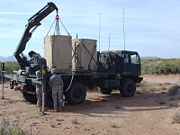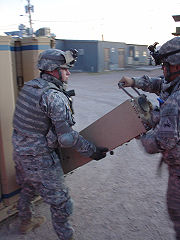
XM501 Non-Line-of-Sight Launch System
Encyclopedia
The Non-Line of Sight Launch System (NLOS-LS) was a self-contained missile
launcher system that was under development by NETFIRES LLC, a partnership between Lockheed Martin
and Raytheon
. Each Container Launch Unit (CLU) holds 15 missiles, and a self-locating networked communications system. CLUs can be linked for coordinated launching, with the missiles fired and controlled remotely via autonomous vertical launch. The weapon is roughly 2 meters tall.
The program was canceled early 2011. It was being developed for the United States Navy
's Littoral Combat Ship
, but has been criticised for performance issues. The Griffin missile
has been recommended for use instead. NLOS-LS was to be use primarily on the United States Army
's Future Combat Systems
before it was canceled.

 There were to be two types of missile used with NLOS-LS: the Precision Attack Munition (PAM) and the Loitering Attack Munition (LAM). The LAM was originally contracted to Lockheed Martin Missiles and Fire Control
There were to be two types of missile used with NLOS-LS: the Precision Attack Munition (PAM) and the Loitering Attack Munition (LAM). The LAM was originally contracted to Lockheed Martin Missiles and Fire Control
, but the contract was terminated after costs rose and tests went poorly. As it stands now, the PAM is the only armament currently being designed for the NLOS-LS.
s, and other targets of opportunity. Uses 3 modes of guidance
, GPS/INS, semi-active laser homing, and autonomous imaging infrared. Carries a multi-mode warhead
effective against several types of targets. It also includes an online library of pictures of targets, so that it can visually identify what it is homing in on.
)
Missile
Though a missile may be any thrown or launched object, it colloquially almost always refers to a self-propelled guided weapon system.-Etymology:The word missile comes from the Latin verb mittere, meaning "to send"...
launcher system that was under development by NETFIRES LLC, a partnership between Lockheed Martin
Lockheed Martin
Lockheed Martin is an American global aerospace, defense, security, and advanced technology company with worldwide interests. It was formed by the merger of Lockheed Corporation with Martin Marietta in March 1995. It is headquartered in Bethesda, Maryland, in the Washington Metropolitan Area....
and Raytheon
Raytheon
Raytheon Company is a major American defense contractor and industrial corporation with core manufacturing concentrations in weapons and military and commercial electronics. It was previously involved in corporate and special-mission aircraft until early 2007...
. Each Container Launch Unit (CLU) holds 15 missiles, and a self-locating networked communications system. CLUs can be linked for coordinated launching, with the missiles fired and controlled remotely via autonomous vertical launch. The weapon is roughly 2 meters tall.
The program was canceled early 2011. It was being developed for the United States Navy
United States Navy
The United States Navy is the naval warfare service branch of the United States Armed Forces and one of the seven uniformed services of the United States. The U.S. Navy is the largest in the world; its battle fleet tonnage is greater than that of the next 13 largest navies combined. The U.S...
's Littoral Combat Ship
Littoral combat ship
A Littoral Combat Ship is a type of relatively small surface vessel intended for operations in the littoral zone . It is "envisioned to be a networked, agile, stealthy surface combatant capable of defeating anti-access and asymmetric threats in the littorals." Two ship classes are the first...
, but has been criticised for performance issues. The Griffin missile
Griffin (missile)
The Griffin is a short-range air-to-surface missile developed by Raytheon for UAVs. It is tube-launched, with a 5.5 inches diameter, weighs 45 pounds, and has a semi-active laser seeker. It has a 13-lb warhead, smaller than the Hellfire typically used by armed UAVs, which has the effect of reducing...
has been recommended for use instead. NLOS-LS was to be use primarily on the United States Army
United States Army
The United States Army is the main branch of the United States Armed Forces responsible for land-based military operations. It is the largest and oldest established branch of the U.S. military, and is one of seven U.S. uniformed services...
's Future Combat Systems
Future Combat Systems
Future Combat Systems was the United States Army's principal modernization program from 2003 to early 2009. Formally launched in 2003, FCS was envisioned to create new brigades equipped with new manned and unmanned vehicles linked by an unprecedented fast and flexible battlefield network...
before it was canceled.
Concept


Lockheed Martin Missiles and Fire Control
Lockheed Martin Missiles & Fire Control is a Lockheed Martin business unit based in the Dallas suburb of Grand Prairie, Texas. The unit's offensive and defensive arsenal includes air-to-air and air-to-ground missiles, naval rockets and missiles, fire control and sensor systems, fire support...
, but the contract was terminated after costs rose and tests went poorly. As it stands now, the PAM is the only armament currently being designed for the NLOS-LS.
- Height: 69 in (1,752.6 mm)
- Length: 11 in (279.4 mm)
- Width: 11 in (279.4 mm)
Precision Attack Munition (PAM)
Used to attack vehicles, armor, bunkerBunker
A military bunker is a hardened shelter, often buried partly or fully underground, designed to protect the inhabitants from falling bombs or other attacks...
s, and other targets of opportunity. Uses 3 modes of guidance
Missile guidance
Missile guidance refers to a variety of methods of guiding a missile or a guided bomb to its intended target. The missile's target accuracy is a critical factor for its effectiveness...
, GPS/INS, semi-active laser homing, and autonomous imaging infrared. Carries a multi-mode warhead
Warhead
The term warhead refers to the explosive material and detonator that is delivered by a missile, rocket, or torpedo.- Etymology :During the early development of naval torpedoes, they could be equipped with an inert payload that was intended for use during training, test firing and exercises. This...
effective against several types of targets. It also includes an online library of pictures of targets, so that it can visually identify what it is homing in on.
Specifications
- Weight: 117 lb (53.1 kg)
- Diameter: 7 in (177.8 mm)
- Length: 60 in (1,524 mm)
- Guidance: GPS/INS, imaging infraredInfrared homingInfrared homing refers to a passive missile guidance system which uses the emission from a target of electromagnetic radiation in the infrared part of the spectrum to track and follow it. Missiles which use infrared seeking are often referred to as "heat-seekers", since infrared is just below the...
, semi-active laser homing. - Datalink: Networked for in-flight updates, retargeting and images.
- Motor: Variable thrust rocket motor.
- Range: 25 mi (40.2 km)
Loitering Attack Munition (LAM)
Designed to fly to a preset area and loiter while autonomously seeking out targets.Specifications
- Weight: 117 lb (53.1 kg)
- Diameter: 7 in (177.8 mm)
- Length: 60 in (1,524 mm)
- Guidance: GPS/INS, laser radar (LADAR) seeker with automatic target recognitionAutomatic Target RecognitionAutomatic target recognition , is the ability for an algorithm or device to recognize targets or objects based on data obtained from sensors....
. - Datalink: Networked for in-flight updates, retargeting and images.
- Motor: Micro turbojet.
- Range: 45 mi (72.4 km) with 30 min loiter time.
Development
- November 2002 – First guided flight of Precision Attack Missile.
- December 2005 – Successful Loitering Attack Missile Boost Test Vehicle (BTV) flight test at Eglin Air Force Base, FL.
- April 2007 – Successful test launch of a Precision Attack Missile from a CLU at White Sands Missile RangeWhite Sands Missile RangeWhite Sands Missile Range is a rocket range of almost in parts of five counties in southern New Mexico. The largest military installation in the United States, WSMR includes the and the WSMR Otera Mesa bombing range...
. - June 2007 – Successful test of Precision Attack Missile warhead against a fortified bunker.
- November 2008 – Successful first test of Precision Attack Missile fired from Container Launch Unit. Scores hit on T-72 tank.
- May 2009 – Captive flight test clears way for over-water flights to test capability against small boats.
- Feb 2010 – Four out of six missiles fail to hit their targets in a Limited User Test.
- April 2010 – US Army calls for program to be canceled.
- 3 May 2010 – The U.S. Army removes the system from their website.
- 12 May 2010 – House Armed Services seapower and expeditionary forces subcommittee moves R&D funding to Navy budget.
- 18 May 2010 – Defense Department approved an Army recommendation to cancel the program
- 6 Jan 2011 – DefSec Gates announces end of program.
- 2012 – US Navy was to begin at-sea testing of LCS surface missile module.
See also
The JUMPER missile system from Israel Aerospace Industries uses a similar concept, but with 8 missiles instead of 15 and without the IR seeker.External links
- Non Line of Sight-Launch System - Lockheed Martin
- NetFires NLOS-LS - Designation Systems
- Non-Line-of-Sight Launch System (NLOS-LS) - Global Security
- Precision Attack Missile - Defense Update
- Raytheon Missile Systems NLOS-LS
)

